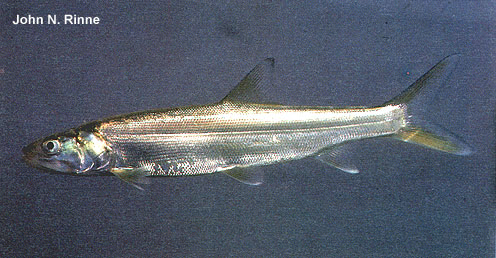| Elopidae (Tenpounders) |
| 91 cm TL (male/unsexed) |
|
pelagic-neritic; brackish; marine; depth range 0 - 10 m, oceanodromous |
| Eastern Pacific: Mandalay Beach, southern California, USA to Peru, including the Gulf of California. |
|
Dorsal spines (total): 0-0; Dorsal soft rays (total): 20-27; Anal spines: 0-0; Anal soft rays: 12-18; Vertebrae: 78-82. Body slender and elongate; mouth large and terminal; bony plate present between branches of lower jaw; branchiostegal rays very numerous (25 to 35); fins lacking spines; lower branch of first gill arch with 16 to 20 gill rakers; scales very small, 100 to 120 in the lateral line; back dark blue-green to light brown; flanks silvery with slight yellow highlights; fins slightly yellowish (ref. 55763). Caudal rays: principal (10+8-9), procurrent (upper:8, lower: 8)
Branchiostegal rays: 23-35 |
| Occur in schools in shallow inshore areas. Penetrate lagoons and estuaries (Ref. 9297). Feed on fish and penaeids (Ref. 50313). Spawning probably occur in the open sea and the transparent larvae migrate towards coastal areas (Ref. 9297). Struggle vigorously when caught on hooks and lines (Ref. 9297). Low commercial value due its numerous spines (Ref. 9297). |
|
Data deficient (DD); Date assessed: 08 August 2018 Ref. (130435)
|
| harmless |
Source and more info: www.fishbase.org. For personal, classroom, and other internal use only. Not for publication.

